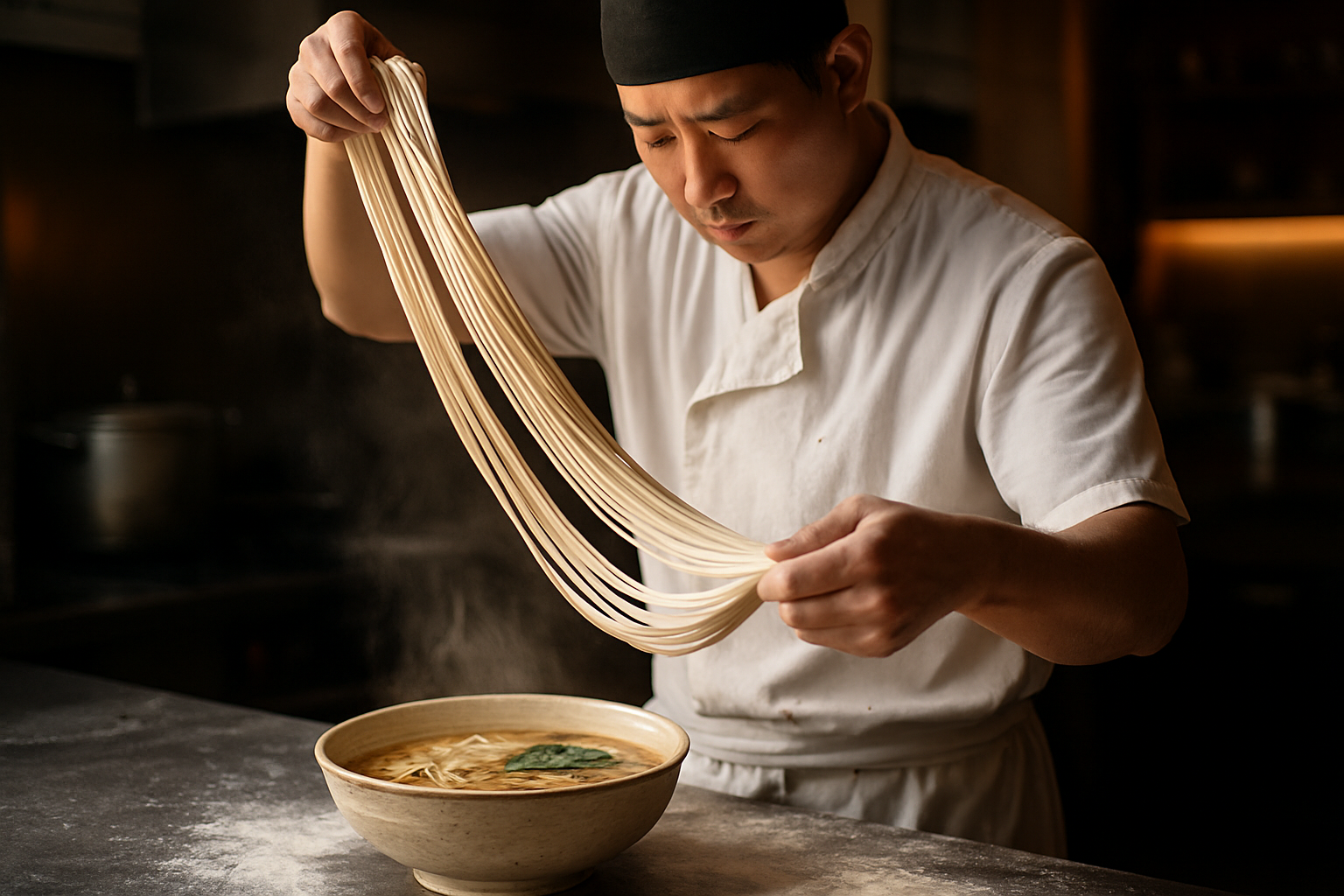Noodle Pulling: The Art of Hand-Stretched Pasta
Slurp your way into the mesmerizing world of hand-pulled noodles. This ancient culinary technique, rooted in Chinese tradition, has captivated food enthusiasts worldwide. Join us as we explore the intricate process, diverse flavors, and modern twists on this timeless craft. Get ready to witness the magic of dough transforming into silky strands before your eyes!

The Science Behind the Stretch
At the heart of hand-pulled noodles lies a fascinating interplay of gluten development and dough elasticity. The process begins with a simple mixture of high-gluten flour, water, and salt. As the dough is kneaded, gluten proteins form long, interconnected chains, creating a stretchy, elastic texture. The addition of alkaline salts, such as potassium carbonate or sodium carbonate, further enhances the dough’s extensibility and gives the noodles their characteristic springy texture. The key to successful noodle pulling lies in achieving the perfect balance of gluten development and relaxation. Noodle masters often let the dough rest for hours or even overnight, allowing the gluten to relax and become more pliable. This resting period is crucial for achieving the ideal texture and preventing the dough from breaking during the stretching process.
Mastering the Technique
Learning to pull noodles by hand is a skill that requires patience, practice, and a deep understanding of dough behavior. The process begins with dividing the dough into manageable portions and shaping them into long cylinders. The noodle maker then repeatedly stretches and folds the dough, using a combination of gravity and centrifugal force to elongate the strands. As the dough is pulled, it becomes thinner and more uniform, with skilled practitioners able to create noodles as fine as hair or as thick as belts. The rhythm and motion of noodle pulling are often described as a dance, with practitioners developing their own unique styles and techniques. Many noodle masters incorporate acrobatic moves into their pulling process, twirling and swinging the dough in elaborate displays of skill and showmanship.
Regional Variations and Flavors
While the basic technique of hand-pulled noodles remains consistent across cultures, regional variations have given rise to a diverse array of flavors and textures. In Lanzhou, China, hand-pulled noodles are typically served in a clear, flavorful broth with tender beef and aromatic spices. Japanese ramen shops often incorporate hand-pulled noodles into their rich, creamy tonkotsu broths, creating a perfect balance of chewy noodles and velvety soup. In Korea, hand-pulled noodles are the star of dishes like kalguksu, a comforting soup featuring knife-cut noodles in a savory anchovy and kelp broth. Each region has developed its own unique combinations of broths, toppings, and seasonings to complement the texture and flavor of hand-pulled noodles, resulting in a wide variety of culinary experiences for noodle enthusiasts to explore.
Modern Twists on a Timeless Craft
As hand-pulled noodles gain popularity worldwide, innovative chefs and food enthusiasts are putting their own spin on this traditional technique. Some are experimenting with unconventional flours, incorporating ingredients like buckwheat, quinoa, or even vegetable purees into their dough for added flavor and nutrition. Others are pushing the boundaries of noodle shapes, creating intricate designs and patterns through careful manipulation of the dough. Fusion cuisines are also embracing hand-pulled noodles, incorporating them into unexpected dishes like Italian-inspired carbonara or Mexican-influenced noodle tacos. As the art of noodle pulling continues to evolve, it serves as a testament to the enduring appeal of this ancient culinary technique and its ability to adapt to modern tastes and trends.
Noodle Pulling Tips & Facts
• The ideal dough temperature for noodle pulling is between 25-28°C (77-82°F).
• A single portion of hand-pulled noodles can be stretched to over 5 meters in length.
• The world record for the thinnest hand-pulled noodle is just 0.22mm in diameter.
• Alkaline salts used in the dough give hand-pulled noodles their signature yellow hue.
• Professional noodle pullers can create over 100 servings of noodles per hour.
In conclusion, hand-pulled noodles represent a perfect blend of tradition and innovation in the culinary world. From their ancient origins to modern interpretations, these noodles continue to captivate food lovers with their unique texture and endless possibilities. Whether you’re slurping a bowl of classic lamian or experimenting with fusion creations, hand-pulled noodles offer a delicious journey into the heart of Asian cuisine. So next time you encounter a noodle master at work, take a moment to appreciate the artistry and skill behind each perfectly stretched strand.





